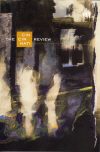The Cincinnati Review – Summer 2013
Now ten years old, The Cincinnati Review has established a reputation as one of the top literary journals in the Midwest. This issue, which includes work by writers such as Porter Shreve, Daniel Anderson, Erin Belieu and Michael Mlekoday, holds up to the journal’s reputation. The issue includes a hefty mix of fiction, poetry, artwork, nonfiction, and reviews, with formal and aesthetic diversity showcased in all categories.
Now ten years old, The Cincinnati Review has established a reputation as one of the top literary journals in the Midwest. This issue, which includes work by writers such as Porter Shreve, Daniel Anderson, Erin Belieu and Michael Mlekoday, holds up to the journal’s reputation. The issue includes a hefty mix of fiction, poetry, artwork, nonfiction, and reviews, with formal and aesthetic diversity showcased in all categories.
In “Sex-Drink ‘80s” from The 80’s: A Brief Primer, Michael Reid Busk utilizes the flash fiction form to make a common scene—and a time period—come alive:
[W]hen couples went to bars before and after having sex, they had to order drinks with old-fashioned, unsexy names. After all, who the hell was Tom Collins? Who was Jack Rose? They needed new drinks, with new names, and since they had sex on the brain it infected the naming of these new cocktails.
In the nonfiction piece “My Mother in Her Mail-Order Scott Paper Company Dress: A Portrait of Intergenerational Neuroses,” Julianna Baggott writes about her memory of her mother’s obsessive compulsive tendencies being exacerbated by “The Big Paper Craze” in the sixties:
During the summer of 1966, my mother mail-ordered two paper dresses. She sent two dollars to the Scott Paper Company, and within a few weeks, she received the dresses—one paisley, the other a black-and-white print—along with a dollar and four cents worth of coupons for Scott paper supplies. Why did my mother order the paper dresses? Out of fashion or thrift? No. She ordered them because she was a deeply neurotic germophobe, and, in many ways, ahead of her time.
Baggott’s mother’s neuroses are passed down to daughter and granddaughter, illustrating a web of family neuroses. In the end, though, it is not a sense of repulsion or resentment that dominates the narrator’s memory of her mother; instead, it is an attempt to categorize the mother’s compulsion of one borne of love:
In my memory, I see her in the kitchen, hands cracked and bleeding from compulsive washing, yet still scrubbing our pots with ferocious energy. She doesn’t let us drink from coffee mugs because of her fear of lead poisoning. She trims the toxic waxy edges off our bologna, scrapes the DDT from our raw meat. She tosses out dented canned goods. She hovers when we’re sick. She worries, and it is a prayer.
Why? Because she loves us, and her love is an engine that can’t rest—even when she knows it should.
In poetry, Michael Mlekoday’s “Forage” stands out as one of the best pieces amid a large sampling. More than just an articulation of hunger or an explanation of poverty, “Forage” is a strange and unabashed admission—not necessarily of guilt, but of the boundaries that needed to be broke to satiate a hunger:
I have skinned
the animal I found in me
& watched him wrench himself
back into the flesh,
I have made gods
of my skinned hands.
I, all thirty-two teeth
of me, yes.
In all, The Cincinnati Review features a strong collection of work in several genres that is strong, evocative, and well worth a read.
[www.cincinnatireview.com]





